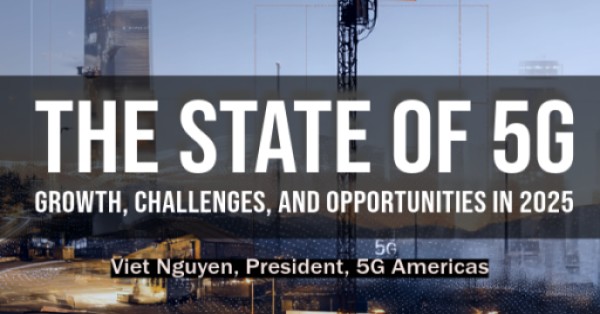By Viet Nguyen, President, 5G Americas
As of April 2025, 5G has reached a global inflection point. With more than 2.25 billion connections worldwide, adoption is accelerating at a rate four times faster than 4G during its corresponding growth phase. This rapid scale-up reflects a global commitment to next-generation mobile infrastructure—driven by national strategies, operator investments, and the growing demand for high-capacity wireless services.
At the same time, the conversation around 5G has matured. As an industry, we’ve moved beyond the hyperbole that often accompanies technological change. Today’s dialogue focuses not just on what 5G can do in theory, but on how it is being implemented in practice. The result is a more grounded, more strategic view of 5G as a foundational infrastructure for economic and digital transformation.
A Global Network Reaching Maturity
Nowhere is 5G’s momentum more clearly visible than in North America, where the technology has achieved some of the highest adoption rates in the world. As of year-end 2024, the United States and Canada together account for more than 182 million 5G connections, representing a nearly 20% year-over-year growth rate. These figures put North America at the forefront of 5G penetration—not just in terms of coverage, but in how deeply integrated technology is becoming across consumer and enterprise segments.
This leadership is no accident. Operators in the region have moved swiftly to deploy nationwide 5G networks across low-, mid-, and high-band spectrum. Initial deployments focused on mobile broadband and device upgrades, but the scope has quickly expanded. Fixed Wireless Access (FWA), referred to by one industry analyst as“America’s preferred next Internet connection,” has emerged as a strong use case by offering a viable alternative to traditional broadband in both urban and underserved rural areas. In parallel, enterprise use cases in logistics, energy, healthcare, and manufacturing are beginning to take root—especially in environments where mobility and low-latency connectivity are operational necessities.
The result is a vibrant and growing 5G ecosystem. With a mature device market, strong operator investment, and an accelerating shift toward standalone architecture, North America continues to set the pace for 5G innovation. While other regions—particularly parts of Asia and Europe—have achieved scale in terms of total subscriptions, North America leads in per capita adoption and network performance, reinforcing its position as a global center for wireless technology development. As of early 2025, Ookla reports that U.S. 5G network performance has advanced notably, driven by 5G Standalone (SA) deployment. In Q4 2024, the U.S. reached a median 5G SA download speed of 388.44 Mbps—up from 305.36 Mbps a year earlier—surpassing Japan (254.18 Mbps) and China (224.82 Mbps).
As we look ahead, this leadership will depend not just on continued investment, but also on smart policy—particularly in the area of spectrum allocation, where recent setbacks have introduced new challenges. But the foundation is strong. North America’s 5G networks are not just widespread—they are positioned for sustained innovation and value creation in the years to come.
Enterprise 5G: High Expectations, Real Constraints
From the outset, 5G was positioned as a driver of enterprise transformation. It promised ultra-reliable, low-latency connectivity for real-time robotics, predictive analytics, automated logistics, and more. Some of that promise is materializing. Yet the pace of enterprise adoption remains more gradual than many initially expected. By 2030, private 4G/5G networks could account for as much as a fifth of all mobile network infrastructure spending, according to one analyst.
Why the gap? In many cases, it’s the reality of integration. Deploying 5G is not the same as delivering business results. For enterprises—especially in sectors like manufacturing and utilities—adoption cycles are long, and ROI models are still evolving. As we have seen in some analyses, the transformation of core operations can often take up to five to seven years. That timeline reflects the need to align 5G with existing IT systems, cybersecurity requirements, and industrial workflows.

This is particularly evident in private 5G networks. Although we’re seeing successful pilots in automotive plants, logistics hubs, and mining operations, these deployments often remain siloed and limited in scope. They represent important early wins but also highlight the broader challenge: network capability must be matched by organizational readiness and cross-domain integration. Indeed, the reality is that network slicing is growing fast, but its rapid-growth phase has been delayed by a few years because of real-world practical considerations. Nevertheless, network slicing revenue is expected to grow more than 60% each year through 2030.
Standalone 5G and the Path to 5G-Advanced
As we move deeper into the 5G era, the industry is preparing for the arrival of 5G-Advanced—the next major evolution of the 5G standard. 5G-Advanced introduces a powerful new set of capabilities, including improved energy efficiency, enhanced mobility, AI-native network automation, expanded positioning services, and even tighter integration with non-terrestrial and time-sensitive applications.
To unlock these features, however, Standalone (SA) 5G is essential. Unlike Non-Standalone architecture that anchor on LTE cores, SA 5G is built on a fully cloud-native 5G core, enabling key innovations such as network slicing, low-latency service delivery, and differentiated Quality of Service. These capabilities are not just forward-looking—they are foundational for enabling the architectural flexibility that 5G-Advanced requires.
According to the Global Suppliers Association (GSA) 72 operators across 131 countries have launched commercial 5G SA networks as of March 2025. In North America, several major operators are advancing toward broader SA adoption, aligning their roadmaps with the long-term vision of service evolution and enterprise-grade applications. Deployment strategies vary by market and operator, which is natural in a diverse ecosystem where business models, spectrum assets, and technology maturity are not uniform. But the direction is clear: SA is not the finish line—it is the gateway to what comes next.
For enterprises, SA unlocks the potential for greater customization and control, enabling features like localized cores, advanced security frameworks, and dynamic resource allocation through slicing. These are increasingly relevant in verticals such as manufacturing, transportation, and public safety—sectors that demand not just connectivity, but service assurance and operational flexibility.
As 5G-Advanced specifications solidify and begin rolling into commercial infrastructure starting in late 2025 and beyond, SA networks will serve as the critical foundation. Without SA, many of the advanced network functions simply cannot be activated at scale.
The momentum toward SA is building—not only to serve today’s enterprise and industrial use cases, but to future-proof networks for the next generation of digital applications. Operators that invest in SA now are positioning themselves to lead in the era of 5G-Advanced, where programmability, automation, and performance differentiation will define competitive advantage.
Spectrum: The Strategic Bottleneck in the U.S.
One of the most critical challenges facing the U.S. 5G ecosystem today is the lack of access to additional licensed mid-band spectrum. Since the expiration of the FCC’s auction authority in March 2023, there has been no pathway to release new mid-band frequencies—particularly in the 3 to 5 GHz range that is vital for balancing coverage and capacity.

This has become a defining issue for U.S. wireless leadership. While countries in Asia and Europe have moved forward with strategic, harmonized spectrum allocations—including access to the upper 6 GHz band—the U.S. now risks falling behind. Without sufficient mid-band spectrum, operators will face constraints in meeting demand, optimizing networks, and advancing toward the next phase of wireless evolution. At a minimum, the U.S. should take steps to make 7.125 – 8.400 GHz range commercially available for full power use.
That’s why 5G Americas has joined other leading organizations in supporting the “End the Cableopoly” coalition—a broad alliance advocating for a forward-looking spectrum policy that reflects modern connectivity needs. Our position is clear: 5G, and eventually 6G, depend on a robust and continuous pipeline of licensed mid-band spectrum. Without it, national competitiveness, digital equity, and innovation leadership are all at risk.
Reframing 5G as a Platform
To navigate the future of 5G effectively, we need to reframe how we think about it. At 5G Americas, we view 5G as a foundational platform—not identical to traditional infrastructure like electricity or transportation, but increasingly essential to the functioning of digital economies and modern society. It is not about headline-grabbing apps or speculative futures. It is about enabling the systems that underpin modern economies.
This framing helps explain why Fixed Wireless Access (FWA) has become one of the most successful 5G use cases to date. In both the U.S. and Latin America, operators are using 5G to deliver broadband to homes and businesses in areas where fiber is impractical or cost prohibitive. While FWA was not the most talked-about 5G application five years ago, it has proven to be a high-impact solution for addressing the digital divide.
Another area of emerging importance is the integration of Non-Terrestrial Networks (NTNs)—including satellite-based communications—into 5G architectures. Advances in 3GPP standards have paved the way for seamless interoperability between terrestrial and space-based systems, supporting global coverage scenarios for remote monitoring, maritime operations, disaster recovery, and agricultural IoT. These capabilities are particularly relevant for rural, remote, and under-connected regions, and they help position 5G as a truly global platform—not just in reach, but in resilience.
Likewise, many of the most promising 5G use cases are emerging not from flashy consumer apps, but from foundational enterprise and industrial needs—predictive maintenance, real-time visibility in supply chains, and enhanced energy efficiency. These are the quiet enablers of productivity and resilience.
Looking Ahead: Focus, Patience, and Collaboration
As we take stock in 2025, several realities come into sharper focus:
- 5G is delivering on its promise of performance and scale.
- Enterprise value is emerging, but integration takes time.
- Spectrum policy is now the limiting factor for continued growth.
- The future of 5G depends as much on economics and governance as on technology.
This is not a setback—it’s a maturation. The path forward is not about chasing the next big headline, but about doing the hard work of systems integration, regulatory modernization, and stakeholder collaboration. It’s about aligning technical progress with real-world needs and ensuring that the benefits of 5G are widely and equitably distributed.
At 5G Americas, we remain committed to this vision. We will continue to advocate for sound spectrum policy, support operator innovation, and work with governments and industry to ensure that 5G fulfills its role as a platform for sustainable, inclusive digital growth.
In 2025, 5G is no longer theoretical. It is the backbone of modern connectivity. The work now lies in building on that backbone—with patience, precision, and a shared sense of purpose.




































